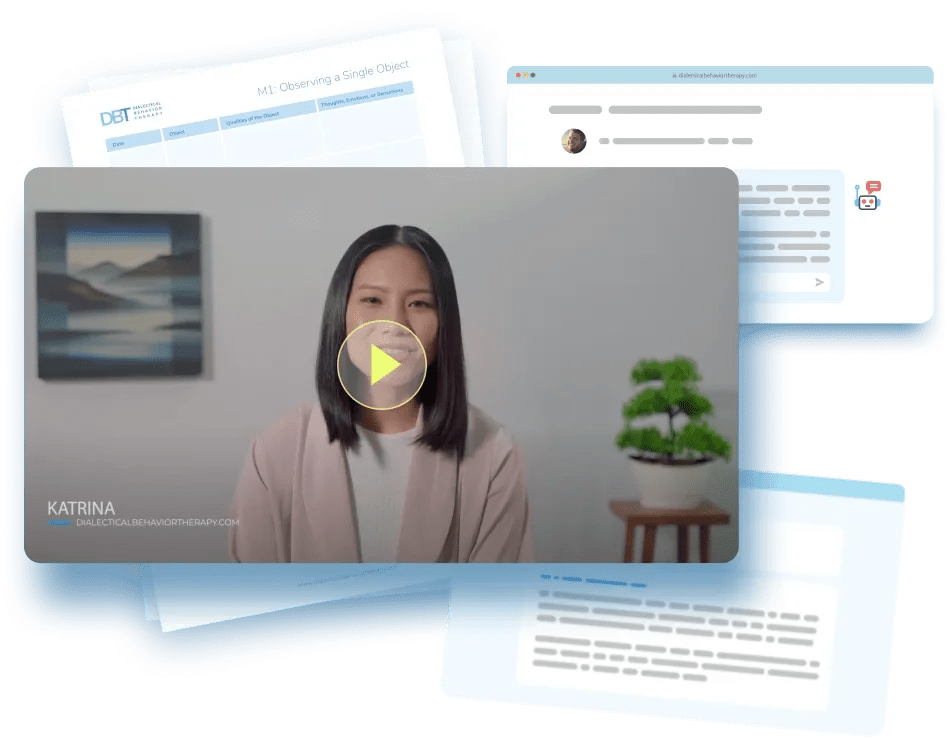E11: STOP Skill
Virtual Coach
Work step-by-step through the Emotion Regulation exercise with the virtual coach.
Introduction
Ever done something in the heat of the moment that you instantly regretted? Snapped at someone. Hit send on a text you wish you could take back. Made a decision that created even more problems?
If you're nodding, welcome to being human. And also, meet your new best friend from DBT: the STOP skill.
STOP is part of the Emotional Regulation and crisis survival toolkit in DBT. It’s a short, powerful technique you can use in the exact moment when your emotions feel too big and you’re about to act impulsively. It’s what you reach for when you want to respond, not react.
Let’s try it.
What STOP Stands For
STOP is a simple yet powerful acronym that can help you pause and respond more wisely in tough moments. This tool helps you catch yourself in the moment, regulate what’s going on in your body, center your mind, and choose the most effective next step. It’s like hitting the pause button before reacting, so you can move forward with more clarity and control.
S – Stop
T – Take a step back
O – Observe
P – Proceed mindfully
This skill works best right in the middle of an emotional spike. When you're feeling angry, anxious, overwhelmed, or pulled to act without thinking. It gives you a small but crucial pause between stimulus and response.
Instructions
S: Stop
Literally stop what you’re doing. Freeze. Don’t speak. Don’t move. Don’t act. Don’t text. Don’t storm out.
You're interrupting the automatic reaction. You're slamming the brakes.
T: Take a Step Back
This pause can be literal, like stepping away from the situation, or mental, like slowing down your racing thoughts. Take a breath. Then another. Take three. Heck, take ten if you need to. Let the adrenaline settle before you act. You can excuse yourself to the bathroom, close your eyes for five seconds, or simply say, “Let me think about this.”
O: Observe
Now tune into what’s happening, without judgment. Start by simply noticing.
What are you feeling in your body? What thoughts are showing up? What’s going on around you? What is the other person doing or saying? You’re not analyzing or reacting yet. You’re just observing. That information helps you figure out if this is truly a crisis, or if it just feels like one.
P: Proceed Mindfully
Now that you’ve slowed down and observed, what’s the most effective thing to do next?
Effective doesn’t always mean pleasant. It means doing what aligns with your goals, values, and long-term well-being.
Ask yourself:
- What do I want from this situation?
- What action will help, not harm?
- What would Wise Mind choose right now?
Examples:
You’re about to get some critical feedback in a team meeting. Your instinct is to either jump in and defend yourself or totally shut down. But instead, you use:
STOP:
S – Stop and say nothing.
T – Take a slow breath, then another, and let your shoulders relax.
O – Observe your chest pounding, that intense urge to escape, and a thought creeping in like, “They think I’m not good enough.”
P – Proceed mindfully by saying, “I’m open to hearing your feedback. Can we go through one point at a time?”
Just like that, you turn what could’ve been a meltdown into a solid, productive moment. That’s the magic of STOP.
Worksheets & Virtual Coach
FAQs
What if I forget to use STOP in the moment?
That’s okay. Everyone slips. Practice helps. Try mentally rehearsing it in low-stress moments so it becomes more automatic during the big ones.
Isn’t this just avoidance?
No. You’re not avoiding. You’re pausing and choosing how to engage instead of reacting impulsively. This is about regulation, not suppression.
How is this different from just taking deep breaths?
Breathing is part of it. But STOP is structured. It walks you through physical, mental, and emotional steps so you can move from chaos to clarity in real time.
What if the other person expects a quick response?
That’s their urgency, not yours. You can say, “I need a moment before I respond,” or “Let me collect my thoughts.” That’s healthy boundary-setting.
What if I recognize the urge after I’ve already reacted?
That’s where Behavior Chain Analysis comes in. It helps you retrace your steps, spot your vulnerability factors, and figure out what you can try differently next time. No shame, just learning.
I feel like my emotions hijack me before I even have a chance to STOP.
Try pairing STOP with TIPP skills (like cold water or intense exercise). These are fast, body-based strategies that can lower emotional arousal enough so STOP can work its magic.
What if my thoughts are racing and I can’t even remember what the S, T, O, or P stands for?
That’s a cue to lean into Mindfulness: Observe and Describe. Simply notice what’s happening in your body and mind without trying to fix it. Observing your thoughts is the first step to slowing them down.
How do I actually practice this outside of crisis moments?
Try using STOP in small, everyday moments: like when you're annoyed in traffic or waiting in a long line. Think of it like emotional weight training. Repetition builds muscle. When you get strong enough for the mild and moderate emotions, you have a fighting chance for emotional crises.
Disclaimer
If you have any behavioral health questions or concerns, please talk to your healthcare or mental health care provider. This article is supported by peer-reviewed research and information drawn from behavioral health societies and governmental agencies. However, it is not a substitute for professional behavioral health advice, diagnosis, or treatment.

